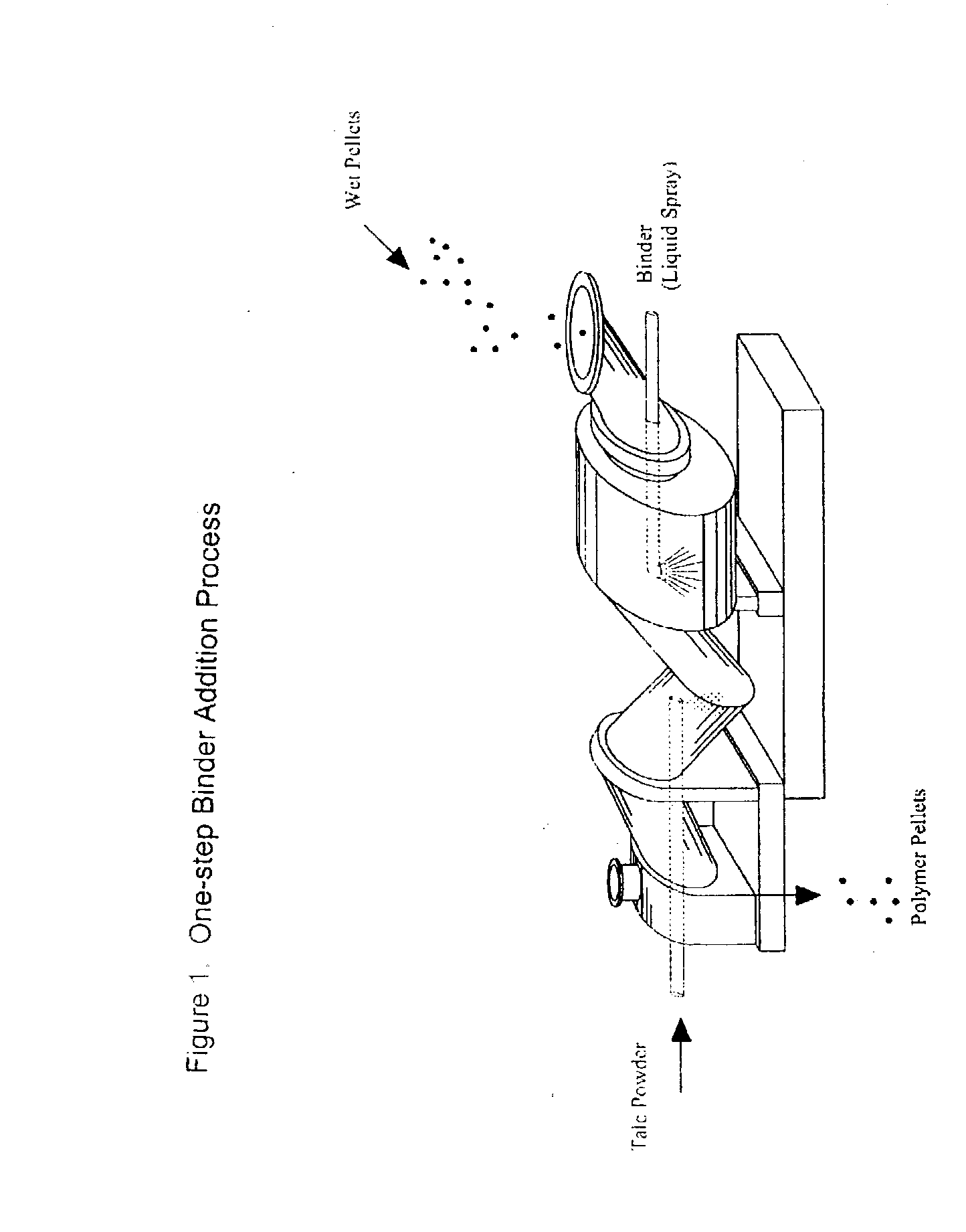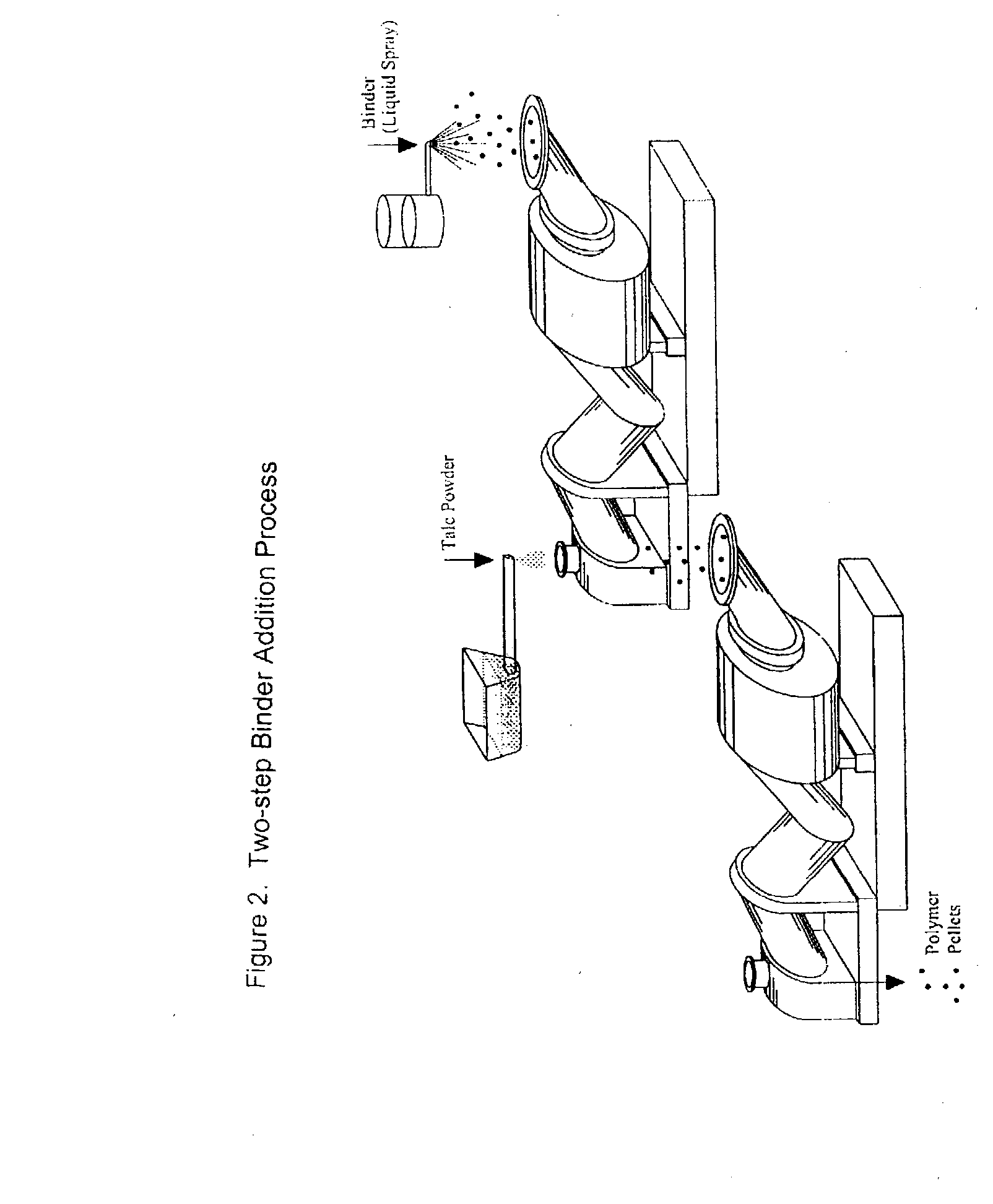Process of Coating Tacky and Soft Polymer Pellets
a technology of soft polymer pellets and tacky, which is applied in the field of processing tacky and soft polymer pellets, can solve the problems of affecting blocking the fusion of individual pellets into a single mass, and reducing the free-flow ability of the pellet surface, so as to achieve the effect of convenient downstream handling
- Summary
- Abstract
- Description
- Claims
- Application Information
AI Technical Summary
Benefits of technology
Problems solved by technology
Method used
Image
Examples
example 2
[0033] (0.06% conjugated linoleic acid):To a one-gallon Dry Powder Rotator (Model 099A-RD9912 from Glas-Col, Terre Haute, Ind.), 500 grams of Wicks BB gum base (L. A. Dreyfus Company, Edison, N.J.) were loaded. The gum base has a softening point of 53-61 degrees C. The gum base is in a pellet form with a diameter about 10 mm. After spraying 1.5 grams of distilled water (0.3% by weight to the gum base) over the gum base, it was shaken for two minutes. This provides the controlled level of moisture to mimic the condition of that fresh out of the spin-dryer. Then, 0.3 grams (0.06% by weight to the gum base) of conjugated linoleic acid (Neobee CLA-80 from Stepan Company, Maywood, N.J.) was sprayed over, and it was shaken for another two minutes. Finally, 20 grams (4% by weight to the gum base) of talc (MP 50-30 USP from Barretts Minerals, Barretts, Mont.) was added, and was shaken for another two minutes before discharge. The talc coating was uniform on the pellet surface with small amo...
examples 3
[0034] (0.12% conjugated linoleic acid):To a one-gallon Dry Powder Rotator (Model 099A-RD9912 from Glas-Col, Terre Haute, Ind.), 500 grams of Wicks BBT gum base (L. A. Dreyfus Company, Edison, N.J.) were loaded. The gum base has a softening point of 53-61 degrees C. The gum base was in a pellet form with a diameter about 10 mm. After spraying 1.5 grams of distilled water (0.3% by weight to the gum base) over the gum base, it was shaken for two minutes. This provides the controlled level of moisture to mimic the condition of that fresh out of the spin-dryer. Then, 0.6 grams (0.12% by weight to the gum base) of conjugated linoleic acid (Neobee CLA-80 from Stepan Company, Maywood, N.J.) was sprayed, and it was shaken for another two minutes. Finally, 20 grams (4% by weight to the gum base) of talc (MP 50-30 USP from Barretts Minerals, Barretts, Mont.) was added, and was shaken for another two minutes before discharge. The talc coating was very uniform on the pellet surface with no free...
example 5
[0036] (0.06% acetylated mono-glyceride):To a one-gallon Dry Powder Rotator (Model 099A-RD9912 from Glas-Col, Terre Haute, Ind.), 500 grams of Gum Base A having a softening point of 62-75 degrees C. were loaded The gum base was in a pellet form with a diameter about 10 mm. After spraying 1.5 grams of distilled water (0.3% by weight to the gum base) over the base, it was shaken for two minutes. This provides the controlled level of moisture to mimic the condition of that fresh out of the spin-dryer. Then, 0.3 grams (0.06% by weight to the gum base) of acetylated mono-glyceride (Acetem 90-50 from Danisco Ingredients USA, Inc., New Centry, Kans.) was sprayed, and it was shaken for another two minutes. Finally, 20 grams (4% by weight to the gum base) of talc (MP 50-30 USP from Barretts Minerals, Barretts, Mont.) was added, and was shaken for another two minutes before discharge. The talc coating was uniform on the pellet surface with a small amount (<20%) of free talc powder.
PUM
| Property | Measurement | Unit |
|---|---|---|
| Fraction | aaaaa | aaaaa |
| Fraction | aaaaa | aaaaa |
| Fraction | aaaaa | aaaaa |
Abstract
Description
Claims
Application Information
 Login to View More
Login to View More - R&D
- Intellectual Property
- Life Sciences
- Materials
- Tech Scout
- Unparalleled Data Quality
- Higher Quality Content
- 60% Fewer Hallucinations
Browse by: Latest US Patents, China's latest patents, Technical Efficacy Thesaurus, Application Domain, Technology Topic, Popular Technical Reports.
© 2025 PatSnap. All rights reserved.Legal|Privacy policy|Modern Slavery Act Transparency Statement|Sitemap|About US| Contact US: help@patsnap.com



